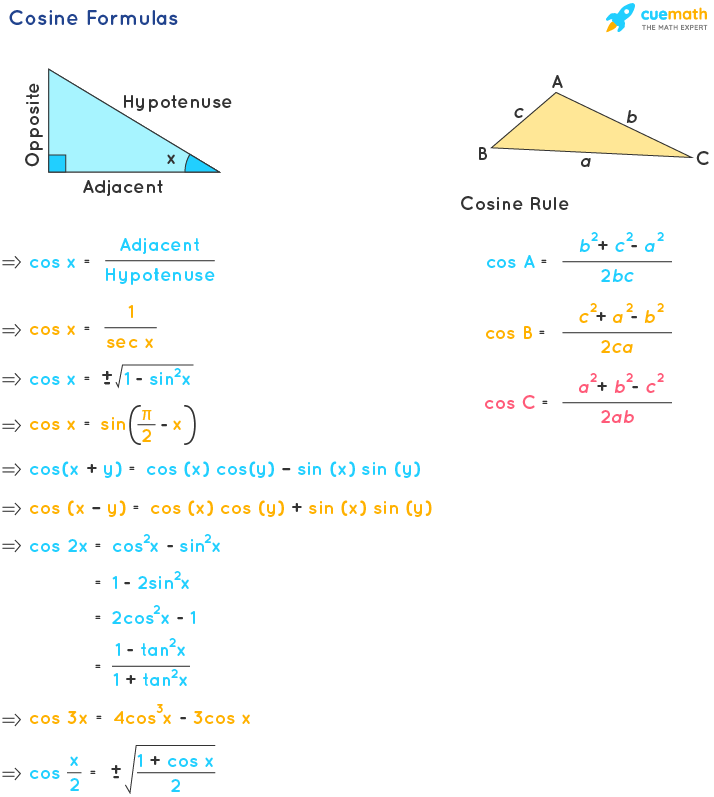Cosine Formulas
The cosine formulas are formulas of the cosine function in trigonometry. The cosine function (which is usually referred to as "cos") is one of the 6 trigonometric functions which is the ratio of the adjacent side to the hypotenuse. There are multiple formulas related to cosine function which can be derived from various trigonometric identities and formulas. Let us learn the cosine formulas along with a few solved examples.
What Are Cosine Formulas?
The cosine formulas talk about the cosine (cos) function. Let us consider a right-angled triangle with one of its acute angles to be x. Then the cosine formula is, cos x = (adjacent side) / (hypotenuse), where "adjacent side" is the side adjacent to the angle x, and "hypotenuse" is the longest side (the side opposite to the right angle) of the triangle. Apart from this general formula, there are so many other formulas in trigonometry that will define cosine function which you can see in the following image.

Cosine Formulas Using Reciprocal Identity
We know that the cosine function (cos) and the secant function (sec) are reciprocals of each other. i.e., if cos x = a / b, then sec x = b / a. Thus, cosine formula using one of the reciprocal identities is,
cos x = 1 / (sec x)
Cosine Formulas Using Pythagorean Identity
One of the trigonometric identities talks about the relationship between sin and cos. It says, sin2x + cos2x = 1, for any x. We can solve this for cos x.
Consider sin2x + cos2x = 1
Subtracting sin2x from both sides,
cos2x = 1 - sin2x
Taking square root on both sides,
cos x = ± √(1 - sin2x)
Cosine Formula Using Cofunction Identities
The cofunction identities define the relation between the cofunctions which are sin, cos; sec, csc, tan, and cot. Using one of the cofunction identities,
- cos x = sin (90o - x) (OR)
- cos x = sin (π/2 - x)
Cosine Formulas Using Sum/Difference Formulas
We have sum/difference formulas for every trigonometric function that deal with the sum of angles (x + y) and the difference of angles (x - y). The sum/difference formulas of cosine function are,
- cos(x + y) = cos (x) cos(y) – sin (x) sin (y)
- cos (x – y) = cos (x) cos (y) + sin (x) sin (y)
Cosine Formula of Double Angle
We have double angle formulas in trigonometry which deal with 2 times the angle. We have multiple double angle formulas of cos and we can use one of the following while solving the problem depending on the available information. They are,
- cos 2x = cos2(x) – sin2(x)
- cos 2x = 2 cos2(x) − 1
- cos 2x = 1 – 2 sin2(x)
- cos 2x = [(1 - tan2x)/(1 + tan2x)]
Cosine Formula of Triple Angle
We have triple angle formulas for all trigonometric functions. Among them, the triple angle formula of the cosine function is,
cos 3x = 4 cos3x - 3 cos x
Cosine Formula of Half Angle
We have half-angle formulas in trigonometry that deal with half of the angles (x/2). The half-angle formula of the cosine function is,
cos (x/2) =± √[ (1 + cos x) / 2 ]
Cosine Formulas Using Law of Cosines
The law of cosines is used to find the missing sides/angles in a non-right angled triangle. Consider a triangle ABC in which AB = c, BC = a, and CA = b. The cosine formulas using the law of cosines are,
- cos A = (b2 + c2 - a2) / (2bc)
- cos B = (c2 + a2 - b2) / (2ac)
- cos C = (a2 + b2 - c2) / (2ab)
Summly the best platform to learn maths ,science and chemistry. We teach slow so that you can it easily.
Examples on Cosine Formulas
Example 1: If sin x = 3/5 and x is in the first quadrant, find the value of cos x.
Solution:
Using one of the cosine formulas,
cos x = ± √(1 - sin2x)
Since x is in the first quadrant, cos x is positive. Thus,
cos x = √(1 - sin2x)
Substitute sin x = 3/5 here,
cos x = √(1 - (3/5)2)
= √(1 - 9/25)
=√ (16/25)
= 4/5
Answer: cos x = 4/5.
Example 2: If sin (90 - A) = 1/2, then find the value of cos A.
Solution:
Using one of the cosine formulas,
cos A = sin (90 - A)
It is given that sin (90 - A) = 1/2. Hence,
cos A = 1/2
Answer: cos A = 1/2.
Example 3: In a triangle ABC, AB = c, BC = a, and CA = b. Also, a = 55 units, b = 70 units, and c = 50 units. Find cos A.
Solution:
Using the cosine formula of law of cosines,
cos A = (b2 + c2 - a2) / (2bc)
= (702 + 502 - 552) / (2 · 70 · 50)
= 5/8
Answer: cos A = 5/8.







No comments:
Post a Comment